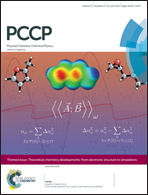Spin decontamination of broken-symmetry density functional theory calculations: deeper insight and new formulations
Abstract
This work re-examines the problem of the broken-symmetry Density-Functional Theory (DFT) solutions in diradical systems, in particular for the calculation of magnetic couplings. The Ms = 0 solution is not an eigenfunction of the S2 spin operator and the evaluation of the singlet state energy requires a spin-decontamination. A popular approximation is provided by the so-called Yamaguchi formula, which operates using the expectation values of S2 relative to both Ms = 1 and Ms =0 solutions. Referring to a previous decomposition of the magnetic coupling in terms of direct exchange, kinetic exchange and core polarization, it is shown that this expression will lead to unreliable values of the singlet–triplet energy gap when the spin polarization of the core orbitals becomes large. The here-proposed method of spin-decontamination is based on the Effective Hamiltonian Theory and uses the overlap between the two degenerate Ms = 0 solutions. An approximate and convenient formula, which uses the expectation values of S2 of the Ms = 0 solutions before and after core polarization is proposed, which is free from the Yamaguchi's formula artefact, as illustrated on an organic diradical presenting a very high value of 〈S2〉 for the Ms = 0 solution, the antiferromagnetic coupling being due to the spin polarization mechanism.

- This article is part of the themed collection: Theoretical chemistry developments: from electronic structure to simulations

 Please wait while we load your content...
Please wait while we load your content...